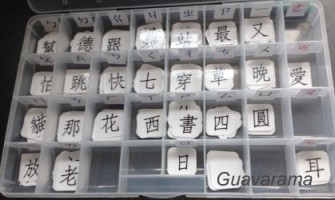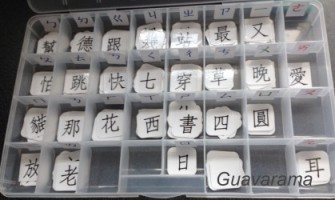
The last 2 weeks, we switched the way we are learning to write Chinese. Probably one of the reasons Thumper is now working mostly entirely by herself during the work period. When Thumper was learning Sagebooks still and practicing writing I made for her. The dictionary was more concrete material based and only contained the Sagebooks characters she knew.
I’m going to step on the soap box here and say, I don’t think kids who don’t know enough characters should be using a dictionary. And when I looked online, kids don’t get dictionaries till later in first grade or second in Taiwan. I could be wrong there, but that was my impression. Here are some reasons:
- I didn’t see the point of her using a dictionary that big when she knew less than 500 characters. Most dictionaries don’t have zhuyin in them so it’s hard to read the text. Maybe that in itself is clue on who should be using these dictionaries.
- The dictionary is a 辭典/詞典. This means you look it up to learn the meanings of a character and also the meanings of words made from that character. Many have stroke order in it. But like its title, it’s a dictionary of words. I’ve seen other dictionaries that are geared toward younger children, some even have etymology. But we don’t have those kinds of dictionary at home.
- Related to that previous reason, Thumper would use the dictionary to look something up, and then come ask me which character is the one she’s looking for! The dictionary then is not doing its job of helping her find a character. You have to be able to read the character first before you can look it up to find meaning of words related to the character. It’s not to be used to figure out which character you’re searching. Okay, I know people use it that way. But that would be more effective if you knew enough characters to be able to use radicals and components to guess which one. She didn’t know that till recently.
- Some people have said they like their children looking up a certain character and then just browsing dictionary to encounter other words. Her zhuyin teacher had her using it. But it took her soooo long each time! It’s like looking things up before Google existed. Kids can browse dictionaries for fun. But if it’s a tool, then it ought to do what you need it for. Why shouldn’t we switch to faster methods if we can? It’s a search tool. We can find other more effective ways for kids to explore the language no?
Chinese-Chinese Dictionary
![]() All this to say, I have finally found a solution to my problem of needing Thumper to find stroke order herself. I think with the number of characters she knows now, she’s ready to use a regular dictionary. But as a search tool, electronic ones are much faster. One Chinese-Chinese dictionary is 萌典.
All this to say, I have finally found a solution to my problem of needing Thumper to find stroke order herself. I think with the number of characters she knows now, she’s ready to use a regular dictionary. But as a search tool, electronic ones are much faster. One Chinese-Chinese dictionary is 萌典.
I’ve had 萌典 for awhile now. It’s got Android and iPhone version. And the data comes from the Taiwan Ministry of Education’s dictionary. But I had only used it when I needed to look up a word to explain in Chinese. However, I recently found out there is a little pencil button next to each character and it will play the stroke order for her! I was originally going to use Anki, but its iPad version is very stupid in terms of looking characters up. If the Taiwanese government’s stroke order website has a mobile version (never bothered to check), I probably would use that too.
Thumper uses the zhuyin keyboard on the iPhone to look up each character. Like a real dictionary, you can also look up a word (not character) for its meaning. I like to use that for Thumper to explain the meaning of something in Chinese.
English-Chinese Dictionary
![]() To find out the meaning of a Chinese word in English for myself, I use Taiwan Dict. It does Chinese to English too. Count me one of those people who stopped using Pleco after 2 weeks because I keep encountering words that Pleco was unable to translate. I know Pleco has other great features. It may have gotten better by now, but it’s too late.
To find out the meaning of a Chinese word in English for myself, I use Taiwan Dict. It does Chinese to English too. Count me one of those people who stopped using Pleco after 2 weeks because I keep encountering words that Pleco was unable to translate. I know Pleco has other great features. It may have gotten better by now, but it’s too late.
I found this dictionary because we were listening to Radio Lab’s episode on the Phytoplankton and was dissatisfied with Pleco’s translation. I chose this dictionary because of its name. Often China uses a different translation than Taiwan. And I’m just trying to stick with one dialect of the language at a time.
I have found for many scientific words, or more modern words, basically Western items, this dictionary often has it. For example, for words like pesto sauce, which I know is called 青醬 in Taiwan but Pleco has a totally different translation. At least Taiwan Dict includes 青醬 in its translations.
Online Dictionaries for Adults
Here are some other dictionaries I’ve used or encountered online when I needed to look characters up. I tend to use more Chinese than English-based websites so I can get the official version. I’m always re-Googling when I need them. So it’s time to put them on a quick reference list!
- Taiwan Ministry of Education’s dictionary I guess you could say this is the official dictionary
- Dictionary of Chinese Character Variants Put out by Taiwanese government. I’ve used it to figure out what is the official Taiwanese version vs the HK version from Sagebook. For example, I learned the other day, Sage’s 曬 is not Taiwanese version, which is 晒. Note though, what’s “official” changed over the years.
- Stroke Order Dictionary - Mentioned quite often to look up animation of stroke order.
- MDBG – I love going to this one to find radicals, components, and words that contain a specific character. And the best part is that I can actually find out the actual pronunciation of said radical or component. There are other websites out there that do the same thing. Yellow Bridge is one. But love the look and feel of this one the best.
- China-Taiwan Chinese Dictionary – Dictionary for finding how equivalent word is said in Taiwan or China. The website is slow.
- Dictionary of Chinese Etymology – This lists the evolution of Chinese characters. There is another website that is way more comprehensive but for teaching purposes this one is fine.


